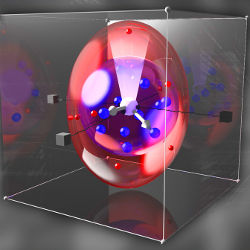
Many researchers are concerned about flat or declining research budgets in computer science and engineering. Although the research community is right to be concerned about the shortage of funds, they should also be concerned about the shortage of scientists and engineers that are willing to serve in governments to address this challenge. Computer scientists and engineers can have a huge impact on the future of the field and the future of the U.S. By serving in the government, they can design and launch new research initiatives, inform IT-related policy decisions, and serve as a catalyst for public-private partnerships involving government, industry, and academia.
In the U.S., one way of advancing computer science and shaping public policy in computer science research and education is by serving in federal agencies that oversee investments in education and research in science and technology. Program and division directors at the National Science Foundation (NSF), the National Institutes of Health (NIH), National Aeronautics and Space Administration (NASA), the Defense Advanced Research Projects Agency (DARPA), the National Institute for Standards and Technology (NIST), the United States Department of Agriculture (USDA), the Department of Transportation (DOT), the Department of Homeland Security (DHS), and many other federal agencies help create national research and development initiatives that can create and/or transform disciplines.
The White House Office of Science and Technology Policy (OSTP) is an agency that works with all other federal agencies. OSTP’s overarching missiona is to “ensure that federal investments in science and technology are making the greatest possible contribution to economic prosperity, public health, environmental quality, and national security.” OSTP also works to formulate policies that can advance science and technology and to make sure in-depth scientific knowledge and expertise in technology are used to inform policymaking. Over the last three years, OSTP has championed a number of new research initiatives that support computer science and engineering, or that harness information technology to advance national priorities and accelerate the pace of discovery in science and engineering.
In recent years, the U.S. government has created two national education and research initiatives that are particularly relevant to computer science and engineering. The National Robotics Initiative (NRI) is a multi-agency initiative designed by OSTP to support research and development in robotics science and technology and promote applications of robotics in manufacturing, healthcare, agriculture, space exploration, national defense, homeland security, civil infrastructure, and education. In June 2011, President Obama unveiled the NRI, with an initial focus on robots that can work with humans to extend and augment human skills. NSF, NIH, NASA, and USDA issued a joint NRI solicitationb and committed over $50 million to develop the science and technology for robots that can safely coexist and operate in close proximity to humans. The NRI now, in its third year, includes a team of over 50 program managers from nine different funding agencies and many of the best U.S. laboratories including the Army Research Laboratory, the Naval Research Laboratory, and the NASA Johnson Space Center. The NRI is broadening in scope to include a wider range of applications and will help strengthen U.S. leadership in robotics science and technology.
OSTP has also designed a closely related interagency initiative in cyber physical systems (CPS) with active participation from NSF, NIST, DOT, and DHS. CPS are smart networked systems with embedded sensors, processors, and actuators that are designed to sense and interact with the physical world (including human users). CPS technology is pervasive and will transform entire industrial sectors, including transportation, healthcare, energy, manufacturing, and agriculture. This initiative addresses the urgent need for research and development for the design and verification of software to provide guaranteed performance, the around-the-clock reliability needed for safety-critical applications; education and training required for CPS applications; and development of standards and reference architectures for CPS in different industry sectors.
The last two years have been particularly exciting for robotics, cyber physical systems, and the Internet of Things.
NSF has already invested in CPS by committing over $140M for CPS research and education over the last four years.c In addition, NSF has created a CPS Virtual Organization (VO),d a network of federal agencies, private industry, and academic research labs actively engaged in CPS research, development, and education. Two White House Presidential Innovation Fellows supported by the National Institute for Standards and Technology (NIST) are addressing sector-specific open test-beds for research and development, and for creating standards and reference architectures for CPS. Industry leaders such as GE, AT&T, Intel, IBM, and Cisco are exploring mechanisms for collaborating with each other and with government agencies and university researchers.
It is important to note that leaders from academia and industry have played a very significant role in shaping both the NRI and CPS initiatives. In 2008, the community pressed to create a National Robotics Week. In May 2009 and then again in March 2013, roadmapse for robotics research, development and education, were presented to the Congressional Robotics Caucus.f OSTP, NSF, NIST, and other agencies held many workshops to help refine the vision for the future of robotics and CPS. In both these initiatives, individuals who served as rotators in the positions of program or division director at NSF, NASA, USDA, and NIH invested resources under their control to create new programs.
The last two years have been particularly exciting for robotics, CPS, and the Internet of Things. For example, on December 2, 2013, Amazon CEO Jeff Bezos announced plans for Amazon Prime Air, which will deliver small packages weighing less than five pounds (which constitute 86% of products shipped by Amazon) using aerial robots in the next five years. Google has acquired robotics companies with expertise in legged robots, low-cost arms, perception, virtual reality, and omnidirectional wheels. Recent reports on the Internet of Things predict economic impact in the tens of trillions of dollars1 and over 75% of business leaders surveyed predicted a direct impact of this technology on their business.2
Federal agencies benefit from leadership in computer science and information technologies.
While there are a number of technology demonstrations in robotics and CPS that suggest that these fields are becoming mature, many of these solutions only work under tightly constrained conditions. The recent DARPA Robotics Challenge serves to highlight many of the open problems in robotics in addition to underscoring the tremendous potential of this field. This is why it is important for all of us to be collectively and continuously engaged in science and technology policy. We need experts that can help identify the most important challenges in robotics and CPS, and that can design high-impact research initiatives to address these challenges.
It is also important to realize that behind the recent avalanche of success stories involving start-ups and investments by major companies is the “snowball” of decades of federal funding in these fields. With targeted investments we can create the scientific and technology breakthroughs that will serve as a catalyst for the industries and jobs of the future. For example, the U.S. federal government should make investments that promote the infrastructure needed for R&D; reduce the “design, build, test” cycle; and attract the next generation of scientists, engineers, and entrepreneurs to advance robotics and CPS, and their applications in domains such as manufacturing, transportation, healthcare, and energy.
Given the importance of these and many other opportunities, it is time for more members of the computer science community to spend time in Washington, D.C. Whether you are in industry or in academia, a student or a professional, we urge you to reach out and connect with federal government agencies whose missions are aligned with your interests. OSTP offers semester-long internships for students of all majors. The Presidential Innovation Fellows (PIF) programg offers six- or 12-month appointments for innovators in the private sector who want to work with the government on developing high-impact technological solutions that can save lives, create new jobs, or make government more efficient. At OSTP, appointments of a year or more are possible through the Intergovernmental Personnel Act (IPA) and this can offer a great opportunity for those who have a sabbatical leave. There are also critical opportunities in other agencies such as NSF and DARPA. Indeed, the creation of the NRI and CPS initiatives was in large part because of individuals that took advantage of these opportunities at NSF.
Agencies like these clearly play a critical role in funding computer science and engineering research and education. However, federal agencies benefit from leadership in computer science and information technology. For example, NIH recently recruited a chief data scientist and many agencies have recruited chief technology officers.
In the U.S., the Office of Science and Technology Policy and many other federal agencies are committed to investing in computer science research and to harnessing information technology to address some of the nation’s most important challenges. In other countries, the agencies responsible for R&D investment and their charters are obviously different. However, as in any country, we cannot do this without the active participation and engagement of creative members of the research community. Democracy is not a spectator sport, and government is only as effective as the people that chose to embrace public service.




Join the Discussion (0)
Become a Member or Sign In to Post a Comment